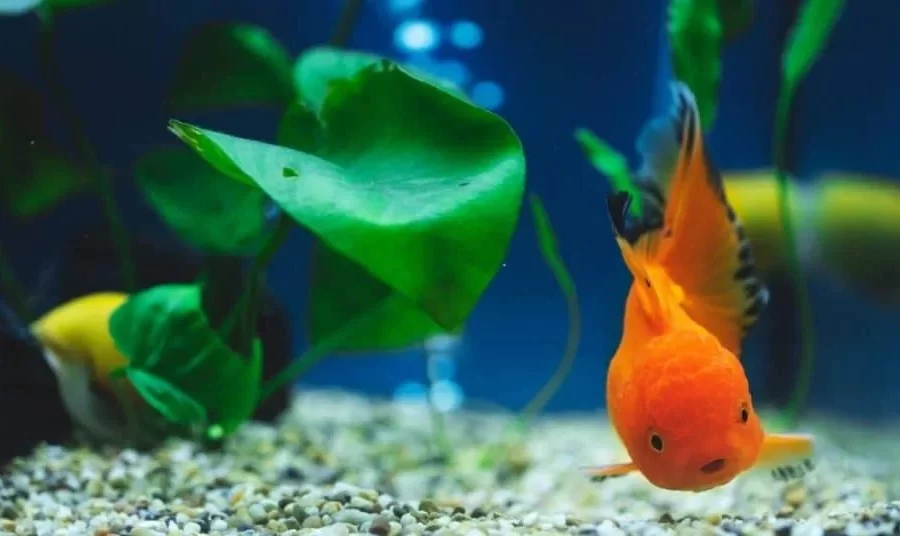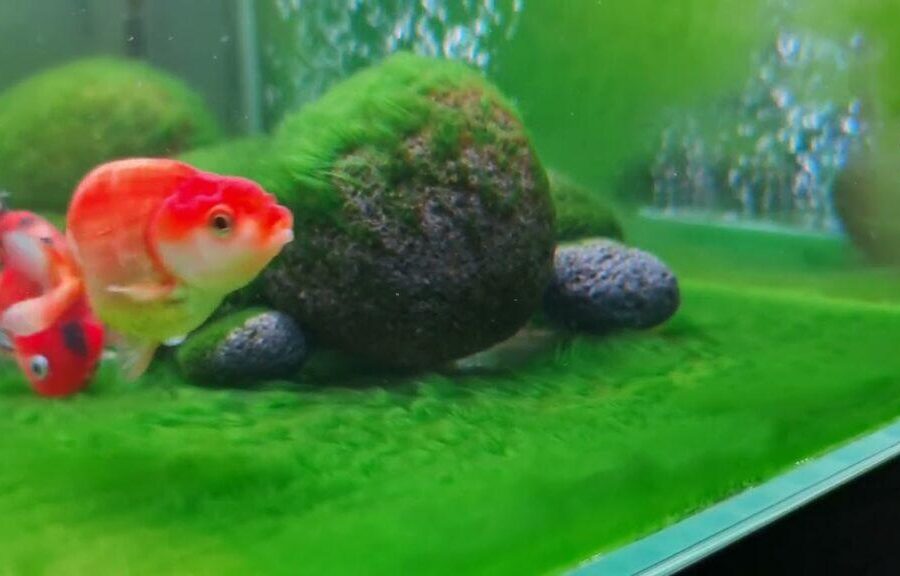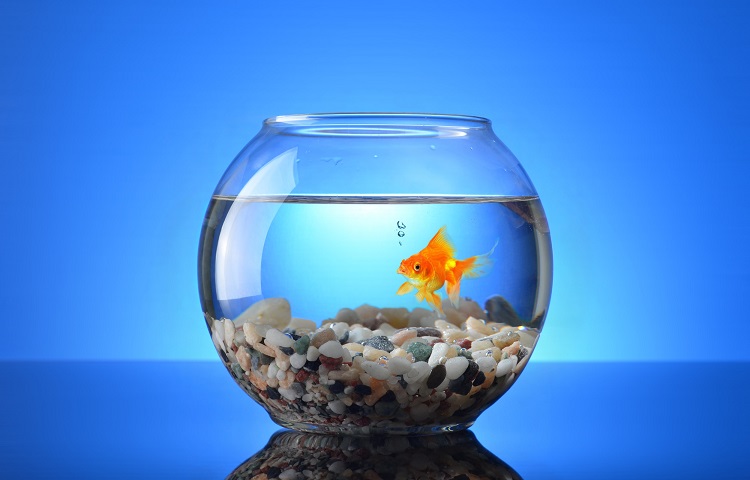
When it comes to goldfish accommodations, tank size matters more than you’d think. It’s a bit like living in a tiny apartment – sure, you can exist there, but are you really living? Our gilled friends experience something similar.
While the classic image of a goldfish in a bowl might be a staple of storybooks, it’s not an ideal setup for real-life scenarios. We’ll dive into that later (pun totally intended). But just know, giving your goldfish room to stretch its fins is as important as giving your cat room to chase lasers. Goldfish, much like us, enjoy a bit of personal space. So, we’ll walk you through the fun, easy-to-read guide on how to make your goldfish’s domestic life feel more like a luxury yacht than a cramped dinghy.
Dispelling the Goldfish Bowl Myth

Hey, goldfish lovers! Let’s chat and spill some myths about our swimming buddies. Most of us grew up thinking a goldfish can thrive in a small bowl. But here’s the truth bomb: it’s simply not enough.
Why a Bowl is Not Enough for Goldfish?
Picture this: you’re relocated to a tiny apartment where you can barely swing a cat. Feels oppressive, right? That’s how your goldfish feels in a small bowl. Firstly, it restricts its personal bubble for swimming freely. And remind me, isn’t a vibrant personality what we love most about our golden finned mates?
Moreover, bowls lack filtration, are oxygen-poor, and have a difficult time maintaining a steady temperature. And guess what our goldfish pals need? Clean water, oxygen, and a stable temperature. These are the basic things of fishy life! And they aren’t possible in a bowl!
The Effects of Small Spaces on Goldfish Health
Now let me break it down to you: a cramped bowl can potentially turn our chipper goldfish into a sickly, unhappy one. Long-term, it can stunt their growth and, even worse, shorten their lifespan which is quite a tragedy.
Imagine your eyes bulging out because of pressure. That’s Pop Eye for you, a common condition in goldfish due to poor water conditions. Also, an unsuitable environment can make our goldfish susceptible to tail rot where its vibrant tail looks all shredded! So yes, a bowl is clearly not just a no, but a heck no!
But hey, don’t lose heart yet. There’s plenty of options to create a healthier home for your goldfish. Up next is to understand your goldfish size and growth, so you can better address its needs. Prepare to be schooled in Fishiology 101!
Understanding Goldfish Growth and Size
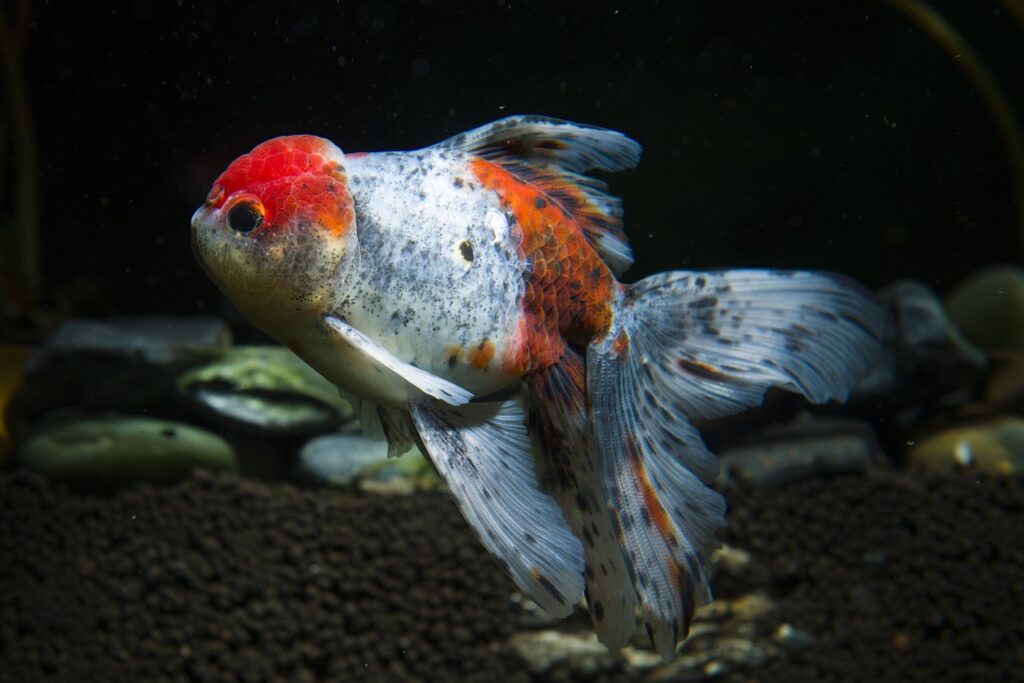
To keep your gold-gleaming friends in peak condition, you need some knowledge about their growth. Who knew, right? But don’t worry, this isn’t next-level biology, it’s just basic goldfish stuff.
Average Size of a Fully Grown Goldfish
Do you remember when you first got your goldfish and it was shorter than your pinky finger? Well, hold onto your hats because a full-grown goldfish isn’t shy about its size! A typical domestic goldfish can reach up to 14 inches in length. That’s almost as long as a basketball is wide! But wait, there’s more. Some koi goldfish varieties can grow up to 36 inches – that’s three whopping feet.
Got that mental picture of a large, shimmering goldfish swimming majestically in its tank? Good, because you’re going to need it for our next topic.
Factors That Influence Goldfish Growth Rate
Just like how diet and exercise work for us humans, certain factors influence how big and how fast a goldfish grows. Nutrition is king here. Your goldfish’s diet should include proteins, carbohydrates, and vitamins. The second factor? You guessed it folks, it’s the tank size! Goldfish are, after all, bound by the finite space they live in. A small tank can even stunt the growth of your fish. Lastly, quality water and good genetics help ensure your goldfish reaches its full potential.
So, now you’re up to speed on goldfish size and growth. I bet you’re wondering how this all ties in with the tank requirements. Well, your patience shall be rewarded because that’s exactly where we’re headed next in our underwater journey.
Ideal Tank Size for Goldfish

Let’s dive deep. Pardon the cheeky pun there, but it’s necessary to lift your spirits before laying down some critical truths about goldfish accommodation.
Minimum Tank Size Requirements
Remember that bus buddy you had in 5th grade who’d hog the entire seat? Turns out, goldfish aren’t too different. Oh, they won’t eat your lunch or poke you with a pencil, but they do demand space. Larger than what a goldfish bowl provides which, by the way, is a cultural travesty we should all work to eliminate. But let’s swim back to our point. The bare minimum size for a goldfish tank is 20 gallons. Yes, you read that right, 20 gallons. That’s around 75 liters if you prefer juggling metric units. This is enough water to keep one goldfish happy and healthy.
And why is this, you ask? Well, goldfish produce a hefty amount of waste. More waste than their bowl-dwelling cousins could ever dream of. This waste can lead to poor water conditions. More room = better water conditions.
Now that we’ve fathomed the depths of the minimum tank size required, let’s move on.
Considerations for Housing Multiple Goldfish
So, you’ve decided to put some glow into your goldfish’s cheeks and bring it a friend, how noble of you! But remember, every additional goldfish requires an extra 10 gallons of space. If you’re excellent in math, you’ve noted that two goldfish need a 30-gallon tank. Believe us, “more the merrier” holds very true for them.
However, don’t just consider the physical space. Remember to factor in variables like species compatibility and tank shape. And be sure to fortify your filtration system when housing multiple fish. A pair of goldfish can party so hard they might just overwhelm a lesser system!
Congratulations! You’ve just become an expert in goldfish housing codes. In the next section, we’ll see how the right size tank can help our finned friends exhibit beautiful, natural behaviors. Diving into the psychology of goldfish? That’s something to eagerly anticipate.
The Impact of Tank Size on Goldfish Behavior
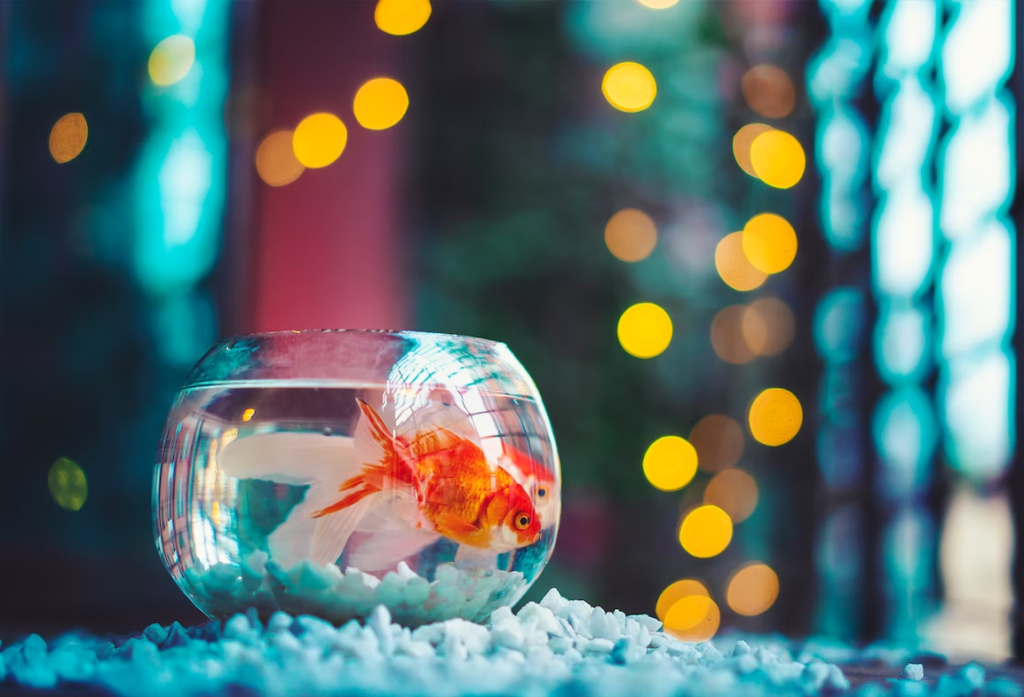
As we navigate life’s wavy waters, we can’t deny that space impacts us. Think about it – don’t you love flitting about in a spacious room compared to squeezing yourself in a stuffy closet? Well, trust me, your goldfish feel the same too.
How Does Space Affect Swimming Behavior?
In bigger tank spaces, goldfish can swim freely. They build stronger muscles and become healthier. Not the kind of healthy where they can bench press a fish food container (they lack the arms, after all…), but the kind of healthy that means living longer, happier fishy lives.
Cramped spaces don’t provide enough room for goldfish to exercise, swimming back and forth like a bored kid in a hallway. This leads to weak, unhappy fish – it’s kind of like living in a stuffy closet, remember?
Social Interaction and Enrichment in Larger Tanks
When it comes to social interaction and enrichment, again, bigger is better. Larger tanks can house ornaments and plants, making a goldfish’s life much more riveting than if they were living in a ‘glass bowl’ version of a desert.
More fish-friends can also live in larger spaces, increasing social interaction. Think of it as throwing a little fish dinner party. Just watch out for the fin flapping, it can get quite raucous.
As we sail towards the next section, remember: just like us, Goldfish thrive in a pleasant environment. Next, we’ll dive into choosing the right tank for your aquatic companions. Spoiler alert: the more room, the better. Whether it’s a condominium or a mansion, your goldfish deserve a spacious abode!
Choosing the Right Tank Size for Your Goldfish
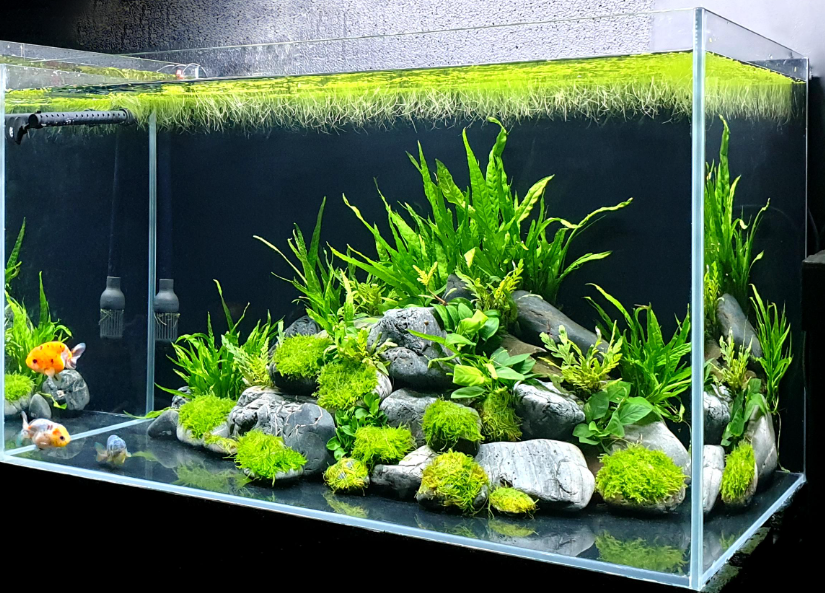
Before we dive right in, let’s take a moment. You have done your homework and you’re excited about bringing home your new finned friend. But wait! You’re not ready just yet. Choosing the right goldfish tank is indeed a science and an art in itself.
What to Look for When Buying a Goldfish Tank
Choosing a goldfish tank is akin to setting up a new home. The tank needs to offer the right space, environment, and amenities. When buying a tank, size is the first thing to consider, not only for aesthetics or the luxury of space but more for health reasons, as we’ve discussed in previous articles.
Beyond the size, the shape of the tank also matters. While hip and funky designs might be tempting, it’s advisable to go for a rectangular tank. You might be wondering why. It’s because rectangular tanks provide a larger surface area for oxygen exchange. Put simply, this means your goldfish can breathe easier and live a healthier life.
With these basic criteria in mind, you’re already setting yourself up for success, placing you ahead of many casual goldfish owners. But, there’s more to learn and consider when it comes to providing the perfect home for your goldfish. For more detailed information, check out our guide on the 10 Best Goldfish Tanks on the Market. This guide will help you better understand the differences and benefits of various tank options available.
Remember, choosing the right tank is an investment in your goldfish’s longevity and happiness. So take your time, do your research, and choose wisely. Happy goldfish keeping!
Investing in the Tank’s Material and Filtration System
Investing in the right materials and filtration system will save you from future headaches.
Glass tanks are a tad pricey, but they resist scratches better than acrylic ones. They also won’t turn yellow over time.
Don’t forget the filtration system. While goldfish are not divas, they do like their water crystal clear. A reliable filter helps keep the water clean and reduces the risk of diseases.
We have now surfed through the sea of information on choosing the right goldfish tank. But the journey has not ended yet!
Let’s swim a bit deeper into maintaining a healthy tank environment in the next section. Remember, we’re creating a beautiful underwater paradise here, one essential detail at a time!
Tips to Maintain a Healthy Tank Environment

Having a splendid tank setup for your goldfish is half the battle — now we enter the fight to keep it pristine! With a little routine maintenance and prompt attention, you’ll have a tank that Poseidon himself would be proud to call home!
Routine Cleaning and Water Changes
Goldfish are not the tidiest of roommates and tend to leave a bit of a mess in their wake. This means that regularly cleaning their tank isn’t just for aesthetics — it’s a health essential. Commit yourself to weekly water changes of about 10-20% and a thorough clean-up at least once a month. Brushing away the algae, vacuuming the gravel, and ensuring a gleaming glass pane will create a beautiful home for your goldfish. It’s like a personal spa day for them, and we all love those!
Keeping your tank clean is not just good hygiene, it helps keep your goldfish happy and healthy. But there’s another element that can make or break their comfort in the tank – the water temperature and pH levels.
Monitoring Water Temperature and pH Levels
Now, not to alarm you, but goldfish are heat-sensitive beings and prefer their tea — I mean, tank water — at a just right temperature of around 65-75°F (18-24°C). Monitoring the tank temperature is no Herculean task. An aquarium thermometer will do you the honors.
As for pH levels, Goldfish are quite the neutral fellas. They like a balanced pH between 6.0 to 8.0, with 7.0 being their sweet spot. Luckily, easy-to-use test kits are available to help you keep an eye on this. Imagine it like the Goldilocks story of your goldfish tank – not too acidic, not too alkaline, but just right!
Well, that’s all, folks! With these tips up your sleeve and the best goldfish mom or dad mindset, you’re all set to create a jazzy little bubble world for your aquatic pet to thrive in. Happy fish-keeping!
To Sum Up
So, there you have it – from busting the goldfish bowl myth to selecting the Hilton of tanks, we’ve got you covered on your quest for the perfect goldfish living conditions. Remember, your aquatic buddy is depending on you to provide a roomy and clean environment that’s not just a puddle, but a palace. Giving them the royal treatment might mean spending a bit more time on maintenance and monitoring, but hey, isn’t it worth it when you see them blissfully swishing their fins in a veritable ocean of luxury?
Just in case we haven’t completely sunk your doubts (or you’re still floating in a sea of confusion), we’ve got a little extra help for you. Check out our Frequently Asked Questions (FAQs) section. It’s crammed with even more helpful tidbits to make sure your goldfish feels more like a sultan than a sardine. Who knows, maybe your goldfish will start demanding caviar with the posh new lifestyle you’re providing!
Frequently Asked Questions (FAQ)
Question 1: Why is a bowl not suitable for goldfish?
Answer: A bowl does not provide enough room for a goldfish to grow and can impact its health negatively due to poor water conditions (like low oxygen levels and accumulated waste).
Question 2: How large does a goldfish typically grow?
Answer: The average size of a fully grown goldfish can range from 10-14 inches. Some goldfish species can grow even larger than that.
Question 3: What is the minimum tank size required for goldfish?
Answer: The minimum tank size for a single goldfish is generally around 20-30 gallons. However, it’s best to provide even more space if possible.
Question 4: Can I keep multiple goldfish in the same tank?
Answer: Yes, but you need to ensure that the tank is large enough to accommodate all of them comfortably. A usual rule is an additional 10-20 gallons per extra goldfish.
Question 5: How does tank size affect goldfish behavior?
Answer: A larger tank not only allows for natural swimming behavior but also encourages social interaction between goldfish, promoting a happier and healthier life.
Question 6: What should I consider when buying a goldfish tank?
Answer: Consider the tank size, material and the inclusion of a good filtration system. Additional accessories like heaters or thermometers may also be necessary, depending on the goldfish species.
Question 7: How often should I clean my goldfish tank?
Answer: A partial water change (roughly 20-30%) is suggested every week, while a thorough tank cleaning should be done every month.
Question 8: What temperature and pH levels are ideal for a goldfish tank?
Answer: Ideal water temperature for goldfish is around 65-75°F (18-24°C), and the perfect pH level should be between 7.0 and 7.5.


